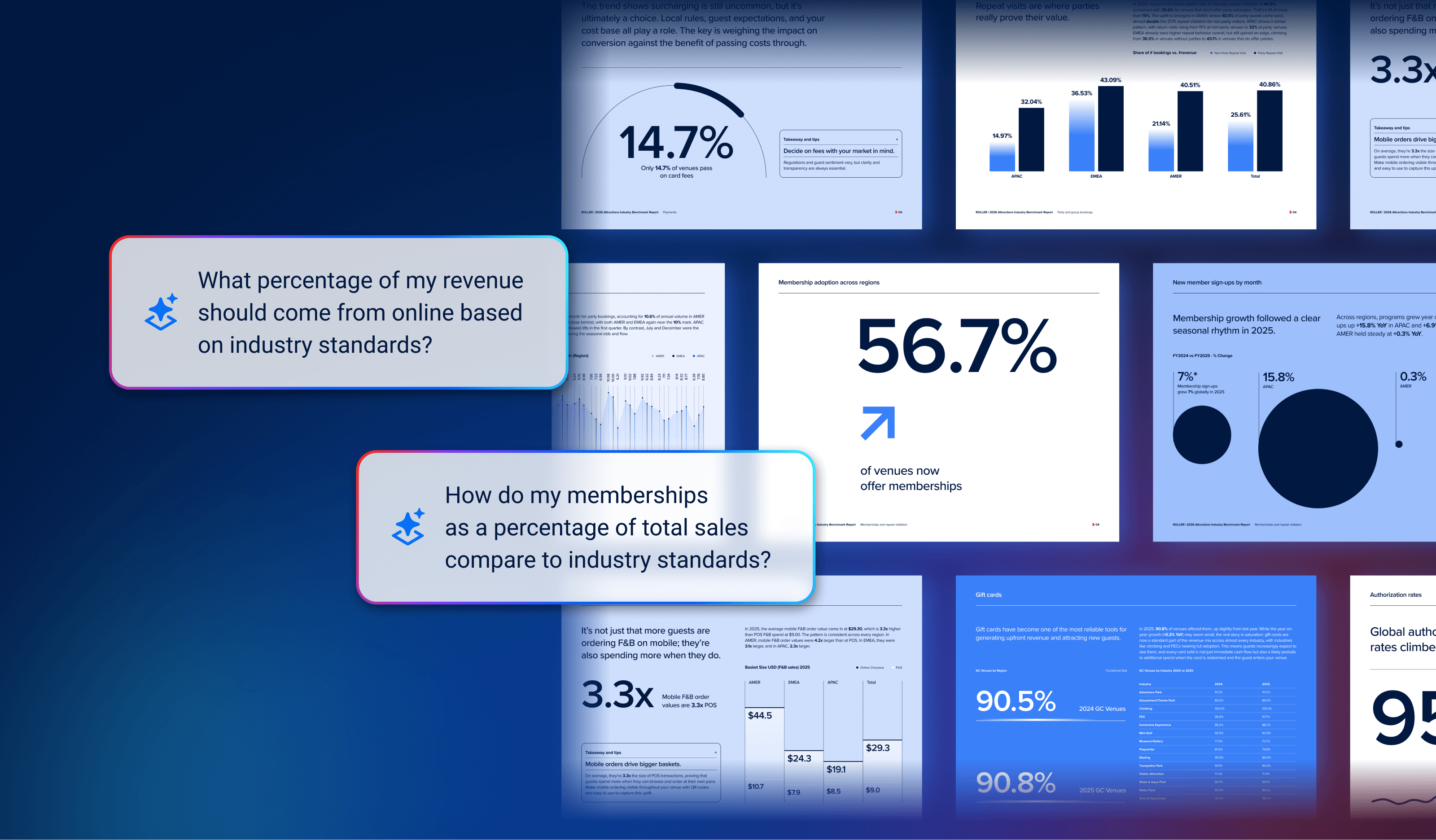The Art of Business Innovation: Redefining Success in the Attraction Venue Industry

Introduction to business innovation
To reference one of the most successful companies of all time, Apple is a company that has mastered the art of business innovation. Apple didn’t invent the computer or the smartphone. However, through tireless effort, they improved upon these products to offer something that not only met the needs of their target market, but offered them something their customers didn’t yet know they needed. Because of this, the brand is legendary.
The attraction venue industry has similar stories. Disney didn’t invent the concept of a theme park. However, through countless innovations, the company has come to define it. Be it theme parks, museums, zoos, or cultural sites, each venue has a unique world of its own and an opportunity to capture the hearts of visitors from all walks of life. In this dynamic landscape, innovation is not just a buzzword; it's the lifeline that separates thriving attractions from those fading into the echoes of the past.
Key takeaways
- Innovation extends beyond new attractions to include service and operational improvements.
- Continuous innovation is essential for staying competitive in the evolving attraction industry.
- Personalizing experiences for visitors is crucial for innovation in attraction venues.
- Effective innovation requires goal-setting, a supportive culture, and adaptability to trends and feedback.
What is innovation in business?
Business innovation is the creation of new value, and better solutions that meet new requirements, unspoken needs, or existing market needs in a novel way. It's not just about inventing something entirely new; it's also about improving and adapting existing services, products, and processes to keep up with the changing times. This concept is pivotal in the attraction venue industry, where customer expectations and technologies are constantly in flux.
For attraction venues, innovation could mean adopting cutting-edge virtual reality or creating immersive experiences that transport visitors to other worlds. It might involve using data analytics to understand visitor behavior better and tailor experiences to individual preferences. It could also mean looking into sustainability initiatives and transforming operations to be more environmentally friendly.
Why innovation is important in business
Businesses that prioritize innovation stay ahead of their competition and set new standards within their industries. This competitive advantage is especially significant in the attraction venue industry, where customer expectations and technology trends shift rapidly. Innovative businesses can preempt these changes, offering novel experiences that differentiate them from their rivals.
Gaining a competitive edge
Innovation can be a crucial differentiator in today's competitive business landscape. It allows companies to set themselves apart and lead market trends. In the attraction venue industry, this means employing unique technologies like augmented reality to create unparalleled visitor experiences and developing innovative services that stand out.
Leading the market
Why play catch-up when you can be at the head of the pack? Moving beyond relevance, innovation positions businesses as market leaders. It's about pioneering initiatives that redefine industry standards. This could involve introducing groundbreaking interactive experiences for attraction venues, setting a new benchmark for what visitors expect and enjoy. Offering an innovative experience typically carries the kind of word-of-mouth buzz marketers dream of.
Driving growth and customer satisfaction
Innovation is key to exploring new markets and enhancing the value offered to customers, leading to revenue and customer base growth. For attraction venues, this involves improving visitor engagement and comfort and tailoring experiences to meet individual preferences, ensuring each visit is memorable and unique.
Enhancing customer loyalty
A commitment to innovation signals a business’s attentiveness to evolving customer needs and preferences, leading to increased satisfaction and loyalty. Visitors will come to associate your venue with novel experiences, making them want to come back for repeat visits. For attraction venues, strategies might include personalizing visitor experiences or leveraging technology to provide streamlined, high-quality services.
Types of business innovations
In the realm of business, innovation can come about in various forms. Understanding and leveraging these innovations is key to staying ahead for the attraction venue industry.
Product innovation
- Definition: Involves the development of new products or significant improvements to existing ones.
- Relevance to attraction venues: This could include launching new attractions, creating immersive experiences with the latest technologies, or upgrading existing facilities to enhance visitor engagement.
Process innovation
- Definition: Refers to the implementation of new or significantly improved operational methods.
- Relevance to attraction venues: Examples include enhancing visitor flow through the venue, implementing eco-friendly operational practices, or optimizing ticketing processes with a customer management platform such as ROLLER.
Marketing innovation
- Definition: Involves developing novel marketing strategies to effectively communicate with and engage customers.
- Relevance to attraction venues: This might come across as unique promotional campaigns, leveraging social media and digital platforms for outreach, or creating personalized visitor experiences through targeted marketing. Innovative ad campaigns are often memorable, generating the most buzz and leading to the best outcomes for your venue.
Organizational innovation
- Definition: Focuses on creating or modifying business structures, practices, and culture to bolster company performance.
- Relevance to attraction venues: For venues, this could entail adopting new management approaches, fostering a culture of creativity and innovation among staff, or implementing employee development programs. Being agile and open to such ideas can allow your venue to adapt quickly to a fickle business climate.
Case studies: Successful business innovations in attraction venues
1. Universal Studios' "Harry Potter and the Forbidden Journey"
- Innovation: Integration of 3D Technology with Trackless Ride Systems and Robo-Coasters.
- Strategy: The ride combines 3D technology, a trackless ride system, and robo-coaster technology. It immerses guests in the world of Harry Potter, using advanced robotics and projection technology to create a highly immersive storytelling experience.
- Features: Guests experience moving through different scenes and environments seamlessly, with the ride system providing a fluid and dynamic motion that enhances the 3D visual effects.
- Outcome: This ride has been a landmark in theme park innovation, setting Universal Studios apart as a leader in ride innovation and immersive storytelling. It's often cited as one of the best theme park attractions globally.
2. Efteling's Garbage System and Animatronics in the Netherlands
- Innovation: Holle Bolle Gijs garbage cans and advanced animatronics.
- Strategy: Efteling created themed environments with small, innovative solutions for storytelling and park maintenance, like themed garbage cans and animatronics for rides.
- Features: The Holle Bolle Gijs garbage cans are not just functional; they're an interactive part of the park's theming, thanking visitors for using them.
- Outcome: These innovations enhanced the park's thematic consistency and improved visitor engagement and park cleanliness. Attention to detail in both attractions and park operations can greatly enhance the overall thematic experience and visitor satisfaction.
3. WaTiki Indoor Waterpark Resort, South Dakota
- Innovation: Incorporating a retractable roof for year-round operation.
- Strategy: WaTiki Indoor Waterpark Resort designed a large retractable enclosure to house various water attractions, allowing for year-round usage regardless of weather conditions.
- Features: The park includes waterslides, pools, and a restaurant.
- Outcome: The adaptable design has made the waterpark a popular year-round destination, increasing its appeal even in the off-seasons. Innovative architectural designs can transform waterparks into versatile, year-round attractions, enhancing their appeal and operational efficiency.
4. The Zephyr River, Super Aqua Club, Quebec, Canada.
- Innovation: Transforming a lazy river into an immersive experience.
- Strategy: The goal was to transform the existing lazy river into a fully immersive aquatic attraction suitable for visitors of all ages. This led to the creation of The Zephyr River, a unique floating journey through a magical jungle.
- Features: The Zephyr River stands out with its innovative use of colorful imagery, enriching sounds, and sensory experiences, all integrated into the lazy river. It offers a unique sequence of experiences for each ride, ensuring no two adventures are the same.
- Outcome: This revitalization of the lazy river has generated significant buzz and has enhanced the overall appeal of Super Aqua Club.
5. Sustainability Initiatives at Waterbom Bali
- Innovation: Implementing comprehensive sustainability programs.
- Strategy: Waterbom Bali set ambitious goals to reduce carbon emissions, focusing on renewable energy, energy use reduction, sustainable travel, and water use efficiency.
- Features: The water park implemented sustainability initiatives, including waste separation, recycling, composting, and participating in environmental programs, putting it on the road to becoming the first carbon-neutral water park in Bali.
- Outcome: These efforts led to significant environmental benefits, such as reduced landfill waste and lower carbon emissions, enhancing the parks' commitment to environmental stewardship. Integrating sustainability into water park operations benefits the environment and positions the parks as responsible and forward-thinking industry leaders, gaining press attention in the process.
How your venue can be innovative
Innovation in the attraction venue industry is a multi-faceted endeavor, combining visitor-focused strategies with a comprehensive approach to strategic implementation. By blending these elements, your attraction venue can continually evolve, staying competitive and relevant in a rapidly changing industry.
Understanding and catering to visitor segments
- Personalization: Tailor experiences based on visitor segments defined by age, interests, or behaviors.
- Customization: Utilize tools like customized journey maps and personalized marketing to make each visitor's experience unique.
Fostering a culture of innovation
- Team involvement: Encourage brainstorming and welcome ideas from all staff levels.
- Beyond technology: Emphasize that innovation includes new methods and ways of thinking, not just technological advancements or new attractions.
Strategic implementation
- Setting goals: Focus on setting specific, measurable goals for your innovation efforts that align with your overall business objectives and visitor needs.
- Measurement and adaptation: Establish metrics to measure the effectiveness of implemented innovations for regular review. This allows for the adaptation and evolution of strategies in response to feedback.
- Risk management: Be prepared to take calculated risks and learn from both successes and failures.
Maintaining continuous innovation
- Industry awareness: Stay updated with industry trends and adapt your strategies accordingly.
- Ongoing process: Treat innovation as a continuous, evolving process rather than a one-time effort.
The future of innovation in attraction venues
The future of innovation in attraction venues looks bright and is predominantly driven by technological advances and the strategic use of customer data. Expect to see more integration of augmented and virtual reality experiences, offering visitors new ways to engage with the venue. Technology will also play a significant role in making operations more efficient, from AI-driven analytics for crowd management to app-based services enhancing the visitor experience.
Another upcoming trend is the increasing importance of sustainability in innovation strategies. Venues will likely focus more on eco-friendly practices, both in daily operations and in the design of new attractions. Moreover, big data and analytics will become more sophisticated, allowing venues to understand and predict visitor preferences and behaviors more accurately. This will enable venues to create more personalized and engaging experiences, thereby increasing visitor satisfaction and loyalty.
FAQs
What is innovation in the attraction venue industry?
Innovation in the attraction venue industry includes introducing new technologies, methods, and ideas that enhance visitor experiences, improve operations, and present novel attractions. This includes advanced virtual reality experiences, eco-friendly operational practices, and creative marketing strategies.
How does innovation benefit attraction venues and their visitors?
Innovation benefits attraction venues by keeping them competitive, relevant, and appealing to visitors. It enhances the overall visitor experience through engaging and unique attractions, improves operational efficiency, and ensures that venues can adapt to changing market trends and technological advancements. For visitors, this means more enjoyable, memorable, and personalized experiences.
In what ways do different types of innovation impact these venues?
Different types of innovations, such as product, process, marketing, and organizational innovations, impact attraction venues. Product innovations offer new and exciting experiences. Process innovations streamline operations and reduce costs. Marketing innovations effectively engage and attract visitors. And organizational innovations improve staff performance and business culture. Each type contributes to the long-term success and sustainability of the venue.
Keeping your venue exciting through innovation
Owning or operating an attraction venue is a constant battle against the tides of change – and a need for innovation. The industry's heartbeat is its ability to evolve, to reinvent the magic that keeps the gates open and the lights on. As such, those who are always looking ahead to the next novel idea – and who are most willing to adapt – are the ones who will most likely captivate hearts and imaginations for generations to come.
Contact the ROLLER team to find out how the right tech partner can help with innovation.
Related articles

.png)
Payment Trends That Will Shape 2026: Insights from the Attractions Industry Benchmark Report

How to Optimize Your Online Checkout: 5 Key Insights from the 2026 Benchmark Report
Enhance your guest experience
Get free education, tips and inspiration to help you run a successful venue.